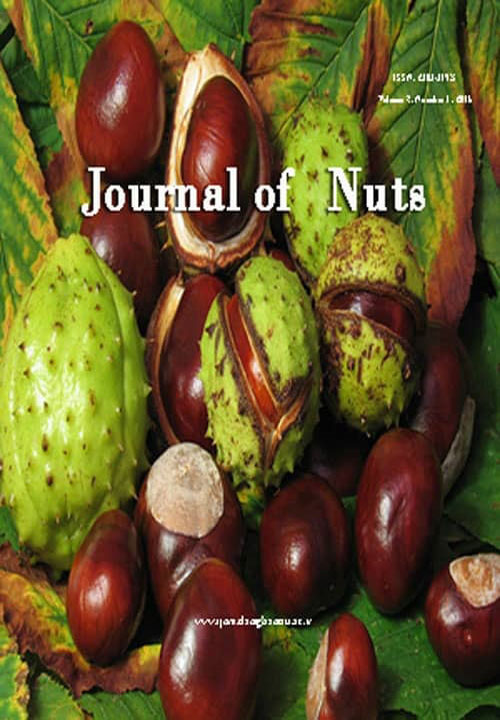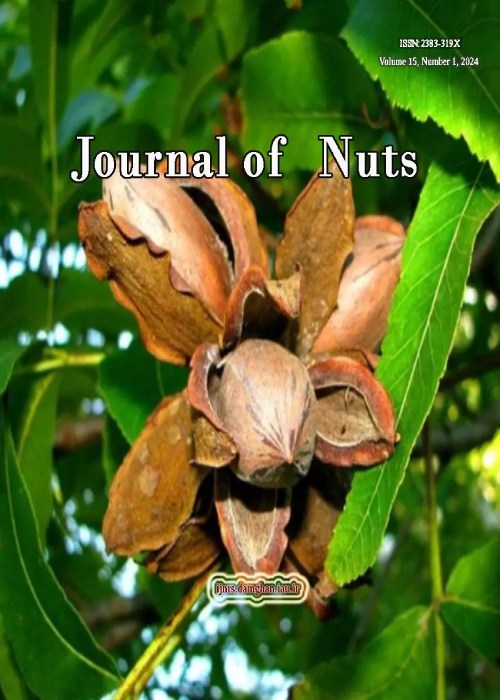فهرست مطالب

Journal of Nuts
Volume:11 Issue: 2, Spring 2020
- تاریخ انتشار: 1399/07/09
- تعداد عناوین: 6
-
-
Pages 109-117The pomological properties and nutritional values of walnuts vary according to the cultivars and ecological conditions. This study aims to determine some pomological properties and fatty acid compositions of some domestic ('Bilecik', 'Maraş 12', 'Maraş 18', 'Şebin', 'Şen1', 'Şen 2') and foreign walnut cultivars (‘Chandler', 'Fernette', 'Fernor', 'Howard', 'Pedro', 'Serr') grown in Bursa (northwest in Turkey) conditions in 2016-2017. The nut weight of cultivars ranged from 9.19 g (Maraş 12) to 16.20 g (Şen 1). Average nutwidth varied from 28.84 mm (Maraş 12) to 38.50 mm (Şen 1), nut thickness was between 27.91 mm (Maraş 12) and 37.09 mm (Şen 1). Nut length was between 34.70 mm (Maraş 12) and 41.63 mm (Şen 1). Kernel percent and shell thickness varied from 41.77 (Pedro) to 58.06% (Şebin) and 1.10 mm (Şebin) to 1.92 mm (Fernor), respectively. The total oil content of the samples ranged from 60.95 (Bilecik) to 66.00% (Şebin). The linoleic acid content ranged from 53.76 (Maraş 18) to 65.37% (Bilecik), and the linolenic acid content was between 8.12 (Şebin) and 11.89% (Bilecik). The oleic acid content of the oils ranged from 12.45 (Bilecik) to 23.21% (Şebin) of the total fatty acids. Palmitic (6.71-11.18%) and stearic acid (2.55-3.97%) were a considerable amount of the remaining fatty acids. 'Şebin,' 'Maraş 18', 'Chandler,' 'Fernor,' and 'Howard' were found to be outstanding cultivars for fruit quality traits and fatty acid profiles in Bursa conditions.Keywords: fatty acid, Juglans regia L, Nut trait, Walnut
-
Pages 119-131
Micrografting can be used to produce healthy seedlings, assess scion-rootstock compatibility and promote precocity. The first objective of this project was to study the impacts of in vitro micropropagation of four major Iranian pistachio cultivars, namely ‘Ahmad Aghaei’, ‘Akbari’, ‘Badami Sefid’ and ‘Kalle Ghochi’ in two different medium Murashige and Skoog (MS) and Driver and Kuniyuki Walnut (DKW) at different concentrations of benzyl adenine (0, 0.5, 1 and 2 mg L-1). The second objective of this project was to examine the effects of ‘Badami-Riz-Zarand’ and ‘Akbari’ rootstocks and micro-scion size (less than 5 and between 5-10 mm) on micrografting of the pistachio cultivars. The results showed that explants of the Akbari cultivar had the highest survival rate of meristems establishment in the DKW medium with 1 mg L-1 benzyl adenine. In the proliferation stage, ‘Akbari’ showed the highest values for proliferation rate, shoot number, shoot length and leaf number whereas, ‘Kalle Ghochi’ had the lowest values for these traits. Moreover, no significant differences were observed between ‘Ahmad Aghaei’, ‘Akbari’ and ‘Badami Sefid’ plantlets in terms of quality during the growing season. The micrografting results on seedlings showed that the scion of the Badami Sefid cultivar with a 5-10 mm size on the ‘Badami-Riz-Zarand’ rootstock had the highest grafting success rate and the lowest cultivar; in contrast, was ‘Kalle Ghochi’ with a scion less than 5 mm on ‘Akbari’.
Keywords: DKW medium, Micrografting, Pistachio, Rootstock, scion -
Pages 133-142
The common pistachio psyllid, Agonoscena pistaciae Burckhardt and Lauterer (Hemiptera: Aphalaridae) is the key pest of pistachio trees in Iran. Nowadays, pistachio growers use detergents widely to control this pest in pistachio orchards. Consequently, the study was carried out to investigate the effects of applying liquid soap (Jonobgan®) 3500 ppm, dishwashing detergent (Rika®) 3500 ppm, and conventional insecticides (spirotetramat (Movento®) 300 ppm and phosalon (Zolon®) 2500 ppm, periodically on some characteristics of “Fandoghi” pistachio trees, including sodium and potassium contents of leaves and bud abscission rate over three years. The field experiments were done in a randomized complete block design with three treatments and three replications in Rafsanjan. The results showed that the application of liquid soap and dishwashing detergent caused no significant variation in sodium and potassium contents of leaves and bud abscission compared to other conventional insecticides. Therefore, detergents can be used safely to control pistachio psyllid.
Keywords: Agonoscena pistaciae, Bud abscission, Leaves elements, side effect -
Pages 143-158Roasted pistachios are among the most delicious nuts in the world. In addition to their pleasant taste, they have significant nutritional and antioxidant effects. This study aims to evaluate the nutritional, sensory, color, and texture attributes of roasted pistachio nuts using fixed and rotary methods at 160 °C during three storage times of 0, 3, and 6 months, at the ambient temperature (20±2°C). The results showed that the moisture percentage of the samples decreased and increased after the roasting process and during the 6-month period of storage, respectively. The available fat percentage of the samples showed no significant change after roasting and storage. The protein content of the roasted samples declined because of the Maillard reaction. Although carbohydrates are less sensitive to temperature than proteins, after the roasting process, the sugar and starch content of the pistachio nuts decreased. Due to the thermal process, the texture was more fragile, and the hardness of the samples decreased. Because of the caramelization and browning reactions that happened during the roasting process, the color of the samples turned dark and less green. These changes intensified after the 6 months of storage. According to the results, quality changes were not significant in the two methods of roasting and storage (p≤ 0.05). Also the temperature and storage time had no specific destructive effect on the nutritional, sensory, color and texture properties of roasted pistachios. Therefore, the use of these two methods of roasting at 160℃ for 15 minutes is recommended.Keywords: Quality, Roasted pistachio, Sensory characteristic, Storage time
-
Pages 159-168This study aimed to extend the shelf life of walnut kernels by appropriate packaging conditions and physical methods. For this purpose, the kernels were heated at 50 or 70°C for 2 or 10 minutes. About 100g of walnuts were packed in low-density polyethylene (LDPE) packages under ordinary, vacuum or nitrogen conditions. Samples were stored for 18 months at room temperature. Peroxide value and acidy number were determined after 6, 12 and 18 months of storage. The results of the variance analysis showed that the effect of packaging conditions on peroxide value, and the effect of all factors on the acidity of the samples were significant (p < 0.01) for the 6- month storage. Walnuts packaged under nitrogen conditions had lower peroxide value than others, and the samples preheated at 70˚C had a lower acidity. After 12 months of storage, the effect of all factors on peroxide and the acidy number of walnuts were significant (p < 0.01). The lowest peroxide value and acidity were observed for walnuts preheated at 50˚C for two minutes. Finally, based on the obtained results, we recommend that walnut kernels should be preheated at 70˚C for two minutes and packaged under nitrogen or vacuum conditions. In this way, they could be stored for six months without perceived oxidation. The oxidation of walnuts would increase during storage for 12 to 18 months gradually, and their peroxide value and the acidity would exceed the desirable limits.Keywords: Nuts, Oxidation, Packaging, shelf life, Walnuts
-
Pages 169-177In this research, the application of walnut shell ash, as an adsorbent for soybean oil bleaching, has been investigated. Therefore, neutralized soybean oil was bleached with 1 and 2% of walnut shell ash as well as commercial bleaching earth. Then, a series of chemical tests such as amounts of carotenoids, chlorophylls, peroxide value, and free fatty acid content of bleached oils and oil retention of adsorbents were determined. The results indicated that bleaching with 2% walnut shell ash reduced carotenoids and chlorophyll contents up to 37.46 and 33.4%, respectively. Moreover, the red and yellow colors reduced in the oil bleached with 2% walnut shell ash and reached to 1.23 and 50 Lovibond, respectively. The oil retention by walnut shell ash (36.99%) was significantly lower than commercial bleaching earth (45.33%). Therefore, as a food waste, walnut shell ash can be used alone or in combination with acid activated earths or activated carbons for oil bleaching as a low cost adsorbent.Keywords: Adsorbent, bleaching, Soybean oil, Walnut Shell


